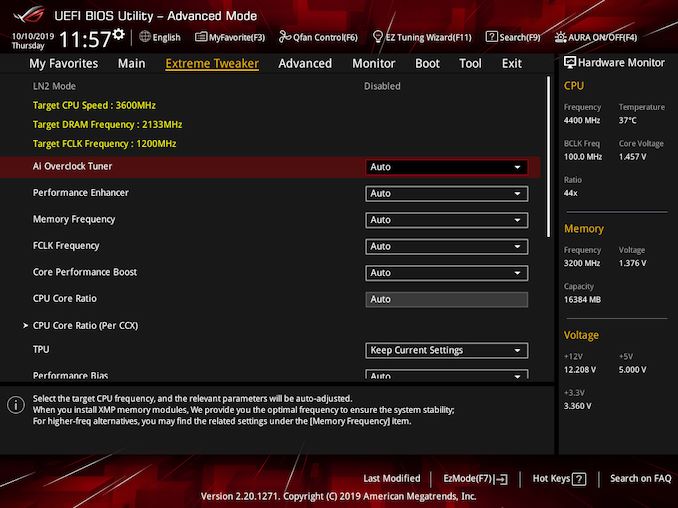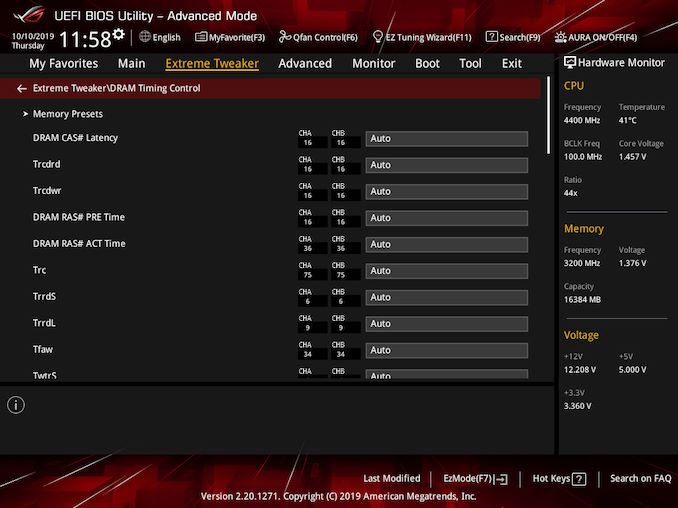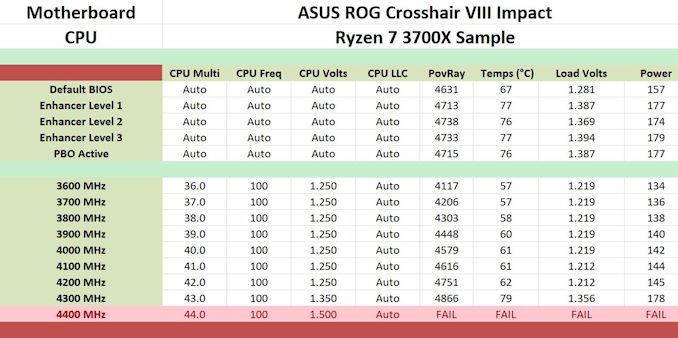The ASUS ROG Crosshair VIII Impact: A Sharp $430 Impulse on X570
by Gavin Bonshor on October 25, 2019 11:30 AM ESTOverclocking Ryzen 3000
Experience with the ASUS ROG Crosshair VIII Impact
Overclocking with the ASUS ROG firmware on the ROG Crosshair VIII Impact is quite pleasant as all of the overclocking related options are located in the Extreme Tweaker menu. For most users looking to overclock the Ryzen 3000 processors, the primary settings to change are the CPU Core Frequency, CPU VCore voltage; memory overclocking can be done automatically by enabling the X.M.P memory profile which ASUS calls D.O.C.P. To make fine-tuned adjustments, ASUS includes plenty of voltage and SoC options, although the ROG Crosshair VIII Impact doesn't support the integrated graphics of the Ryzen APUs as there are no video outputs on the rear panel.
There are no CPU overclocking presets to select from, but users can enable one of the memory presets which are a good starting point for high-binned memory; not only is this expensive but due to the locked Infinity Fabric clock-speed, it becomes less effective without making FCLK adjustments beyond using DDR4-3600 memory. Users can use the firmware fine-tune the primary, secondary, and tertiary memory latencies in the DRAM Timing Control section.
Users looking to make performance-enhancing changes will need to rely on manually overclocking the processors. This is something ASUS ROG is very competent at providing with a whole host of customizable frequency, voltage, and power-related settings for users to chomp on. The firmware on the ASUS ROG Crosshair VIII Impact is well equipped for overclocking, it's very responsive to use and works well. For the more extreme overclockers, there is plenty to appreciate with lots of scope for LN2 cooling with its overclocker's toolkit, an LN2 specific mode, and lots of extreme memory profiles to use as a starting point.
Overclocking Methodology
Our standard overclocking methodology is as follows. We select the automatic overclock options and test for stability with POV-Ray and OCCT to simulate high-end workloads. These stability tests aim to catch any immediate causes for memory or CPU errors.
For manual overclocks, based on the information gathered from the previous testing, starts off at a nominal voltage and CPU multiplier, and the multiplier is increased until the stability tests are failed. The CPU voltage is increased gradually until the stability tests are passed, and the process repeated until the motherboard reduces the multiplier automatically (due to safety protocol) or the CPU temperature reaches a stupidly high level (105ºC+). Our testbed is not in a case, which should push overclocks higher with fresher (cooler) air.
Overclocking Results
The ASUS ROG Crosshair VIII Impact is very efficient with its VDroop at all of the tested frequencies with the firmware set to the auto LLC setting. From 3.6 GHz to 4.2 GHz with 1.250 V set on the CPU VCore in the firmware, we experienced around 0.038 V of VDroop compensation. This not only reduces the overall power consumption at maximum load, but it also helps to reduce CPU temperatures. Moving up to 4.3 GHz at 1.350 V on the CPU VCore, we saw a slight increase to this value at load with a CPU VCore of 1.356 V. We know our Ryzen 7 3700X processor is capable of running 4.3 GHz with slightly less load VCore, but it seems the firmware was playing it safe with a focus on overclocking stability. Our POV-Ray benchmark performance was consistent as we went up in each 100 MHz frequency stepping. The limit on our Ryzen 7 3700X with our testbed cooler is 4.3 GHz, and the Impact couldn't get our chip stable at 4.4 GHz regardless of the voltage we applied.
When it comes to Precision Boost Overdrive performance, and unlike in our review of the GIGABYTE X570 Aorus Xtreme review, the ASUS ROG Crosshair VIII Impact default performance leads us to believe that at default settings, some element of PBO is applied. The performance at default settings in our testing is the equivalent of our testing at 4.1 GHz, which shows the CPU is boosting higher at default settings than some vendors models. We did expect to see some CPU overclocking presets on this model, but this is something ASUS may add at a later date, but it seems the best way to achieve maximum performance is to manually overclock the processor.













59 Comments
View All Comments
RavenRampkin - Sunday, October 27, 2019 - link
Yup, point below me. Little correction *:DPeachNCream - Tuesday, October 29, 2019 - link
Interesting that someone feels compelled to make up rules after the fact when they find an opinion disagreeable. It points to a shortcoming in the security of your own opposing viewpoint when you lash out to say, "Oh yeah? Well you aren't allowed to wear the fire helmet when we play pretend during preschool recess because you played with the police hat last recess." Please, reflect on your thoughts before you allow yourself to lay hands on a keyboard.just4U - Sunday, October 27, 2019 - link
I can't hear the fan on my Strix x570-E at all. The fact that it's hidden from view was a bit of a selling point for me as well. Not thrilled about having chipset fans again but the fans appear to be much better quality than the ones we used to see back when they were common.AshlayW - Monday, October 28, 2019 - link
Oh, please. Have you owned X570? Have you? If not then stop complaining about things you don't know about. Your complaint is completely pointless and it just seems you've hopped on the "complain about the fan" bandwagon.Go overpay for an EOL Z390 that doesn't even have gen4, instead.
PeachNCream - Friday, October 25, 2019 - link
Typo in the Visual Inspection section, second paragraph, first line - "..SO-DIMM.2 slot abouve the main PCIe slot." - Word "above" has an extra letter in it.masteraleph - Friday, October 25, 2019 - link
While I know you haven't reviewed it, the most direct competition to this board is Asus' own X570i Strix board (ITX), which is now appearing in the wild. It also has 2x m.2 slots, one on the back and one under the chipset heatsink. The audio isn't quite as ridiculous, but the power delivery and networking stuff is mostly the same. Would love to see a comparison of the two. The ASRock board is intriguing but lacks a second m.2 slot- while Thunderbolt is great and all, 2x m.2 slots are really nice in a SFF system.mrvco - Friday, October 25, 2019 - link
I'm still unclear what you really get for an extra $140 with the Crosshair over the Strix x570-i (currently $259 on Newegg). Seems like an awful lot of money for upgraded audio with more limited SFF case options.inighthawki - Friday, October 25, 2019 - link
On "System Performance" page at the end:"and the ASUS ROG Crosshair VIII Impact did well with a latency time of 128.2 ms. "
Just FYI i think you mean to write 128.2 us (not ms) to match the table being microseconds.
a5cent - Friday, October 25, 2019 - link
I really wish Anandtech would start including the following in their motherboard reviews:- IOMMU groups
- SR-IOV support for the NIC and GPU (tested using AMD's MxGPU cards)
Dual booting every OS that needs the GPU (I have three, one for CAD, one for gaming and my main, which has Photoshop installed) is getting tiring.
I know AMD and nVidia consider SR-IOV based access to the GPU an enterprise feature, but it's about time to acknowledge that many enthusiasts could also make use of this.
Dug - Friday, October 25, 2019 - link
And performance for USB, the network, data, sound, and tb3 if it has it.It's like they want to ignore all the parts of a motherboard except some basic cpu benchmarks.